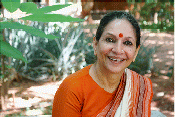
Photo courtesy of Adishakti.
Theatre director Veenapani Chawla passed away on November 30, 2014. She was 67. Although she had been ill for a few months, nobody had expected her health to deteriorate so fast. The theatre community in India was deeply grieved by her premature passing.
Veenapani Chawla came into theatre at a time when it was bursting with experiments worldwide. There was Ariane Mnouchkine, Eugenio Barba and Peter Brook in Europe; K. N. Panicker, Habib Tanvir and Ratan Thiyam in India. This was a time in the country when cultural practices were being viewed through the lens of Indianness. A theatre practitioner had three positions to choose from. The argument for the first was that realistic theatre, although an import from the West, had been so completely assimilated into our cultural life, that it was as Indian as tea. The second and opposite argument was that there had been a rich tradition of theatre in India before the British came and we should return to it. The third, which was Chawla's argument, was that history could not be ignored. If theatre was to address issues that faced mankind today, it could not afford to be revivalist. It had to take a new form altogether.
The issues that concerned Chawla most deeply were neither social nor political, but philosophical. Even in her early years in Mumbai, she had modified plays like Oedipus Rex and Trojan Women to reflect her philosophy, or rather the philosophy of Sri Aurobindo and The Mother which she had made her own. The Sri Aurobindo Ashram in Pondicherry was her spiritual centre and it was to here that she moved from Mumbai, bag and baggage, in 1991.
Her dream theatre space took shape gradually on the outskirts of the city. She transformed a bare tract of land, gifted to her by an admirer of her work, into a verdant campus, the Adishakti Laboratory for Theatre Art Research (ALTAR), where actors' homes, guest houses, a thatched dining shed and an auditorium grew up one by one. This was where Chawla evolved her unique and time-consuming form of theatre. Her plays began with skeletal scripts which she and her actors developed through improvisations and intense rehearsals into the final performance pieces. ‘Final’, however, was always the wrong word to use for Chawla's plays. Their first staging was only the beginning of more rehearsals to fine-tune them and even rewrite parts.
Over the years Chawla evolved what she liked to call a hybrid form of theatre which, she argued, reflected the hybrid character of Indian society. Having already rejected realism in her Mumbai years for physical theatre, she set about enriching her vocabulary with elements from the martial arts, dance and music traditions of Kerala, a State that is rich in them. She also drew on the story-telling and shadow puppetry traditions of Indian folk culture, and, most recently, included computerised animation in a play. Some of the themes she explored were the essential indivisibility of the masculine and feminine principles in human life; the cycle of creativity and destruction that forged a link between human endeavour and the laws of nature; the evolution of a human being from persistent self-questioning to simply being in the world, and the connection between the idea of symmetry/balance and self-destructive aspiration.
Chawla's field of reference was expansive. It ranged from the Indian epics the Mahabharata and the Ramayana to mathematical ideas like Zeno's paradox; from fables like The Hare and the Tortoise to the Red Queen's race from Lewis Carroll's Through the Looking Glass. Consequently, her plays were dense with multiple layers which often befuddled viewers. However, the expert physicality of the actors, the magic of the lighting, the humour (sometimes ribald) and the brilliant use of music to stand as a non-verbal script parallel to the text, kept them intensely absorbed.
The centre of Chawla's work, holding together all its hybrid elements, was Sri Aurobindo's philosophy which posited that the human soul evolved through engaging with life, not by rejecting it. Chawla saw theatre as her path to achieve this. Trying to perfect her work was therefore akin to refining the soul. That is why she used her final hours to suggest changes to The Tenth Head, the last work she had directed. Having done that, she went in peace.
On February 14, Chawla's actors performed the new version of The Tenth Head in Delhi at the invitation of The National School of Drama. There is therefore reason to hope that, although Adishakti is now without its fountainhead, her vision will continue to guide it.
Shanta Gokhale, former Arts Editor of theTimes of India, is a writer, critic and chronicler of Veenapani's work and legacy. Her edited book,The Theatre of Veenapani Chawla: Theory, Practice and Performance, was published in Oxford University Press in March 2014.
Additional information
Notes on contributors

